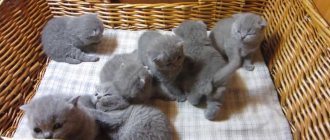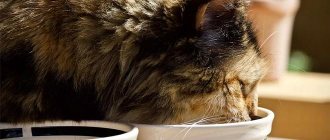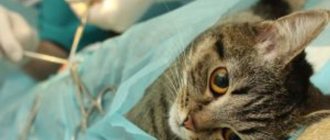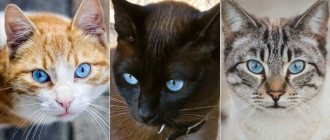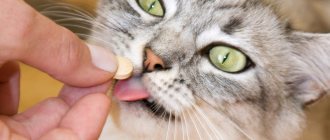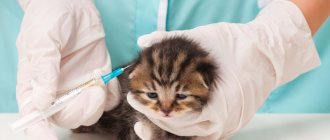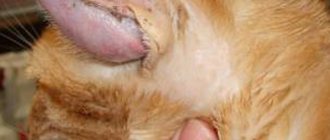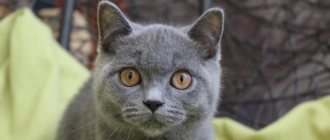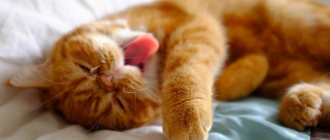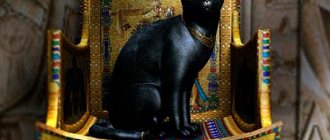One of the most interesting and unusual cat breeds existing in the world is the Canadian Sphynx. The animals got their name in honor of Egyptian figurines found during excavations in Egypt. For some, these animals may seem like charming creatures, but for others they can be unattractive and unsightly. However, one thing is true: those with large eyes, suede skin, beautiful folds and large ears constantly attract attention.
Pet Features
The appearance of Sphynxes differs significantly from the traditional image of cats, but this is precisely what has caused the increased interest in the breed. An adult Sphynx is a harmoniously built animal with soft body lines and correct proportions. Attention is attracted by large ears, piercing eyes, a narrow muzzle, and, of course, the skin is smooth, warm and pleasant to the touch.
Despite the lack of fur, the animal’s heat transfer is quite high, so sometimes it may seem that the cat’s temperature has risen. In fact, it is not higher than that of ordinary cats (38–39 °C), but due to the difference with our temperature, we feel this warmth. The characteristics of Sphynx skin are similar to humans: it is sensitive, can sweat, tan in the sun and requires regular cleansing.
By nature, sphinxes are very sweet, sociable and friendly. They establish a subtle psychological connection with their owner. They feel the mood of their household members, can listen for a long time and express sympathy with a deep, understanding look. They easily get along with other animals in the house, give children a lot of positive emotions and remain playful until old age. The attachment to the owner is so deep that the pet cannot exist separately from him.
Their mobility and playful disposition help sphinxes maintain heat exchange, and the energy expended contributes to increased appetite. Cats of this breed, contrary to myths about picky eating, are actually omnivores, never refuse food and are capable of overeating. Therefore, a properly balanced diet is very important for them.
Breeders recommend feeding your pet with ready-made food containing the entire complex of vitamins. However, there is nothing better than natural food, and here the owner should show strength of character, otherwise an increased appetite can lead to obesity.
Something else interesting: How to wipe a kitten’s eyes
Vitamins and supplements in the Sphynx diet
With a natural type of nutrition, vitamins and supplements must be present in the Sphynx's diet on an ongoing basis. Natural vitamin supplements:
- Meat and bone meal.
- Fish, chicken, beef liver.
- Greens, vegetables, fruits.
- Sunflower oil, olive oil.
- Brewer's yeast.
Pharmacy vitamin supplements:
- Fish fat.
- Feed tricalcium phosphate.
- Omega-3, Omega-6.
- B vitamins.
In addition to vitamins and minerals, kittens and adult animals need taurine.
The rare amino acid is found in the following foods:
- Turkey.
- Rabbit.
- Chicken heart, liver.
- Beef heart.
- Pork, ham, trimmed of fat, after deep freezing.
- Pork liver, heat-treated.
- Ocean fish, shellfish.
- Raw red fish.
- Homemade live yogurt.
- Whole milk.
It may be more convenient for you to give your pet vitamin complexes. Veterinary pharmacies sell a variety of vitamin supplements in the form of treats, gels and powders. Purchasing vitamin complexes involves financial costs, but saves time, effort and greatly simplifies the life of the owner.
The necessary conditions
Sphynx cats are clean and tidy, so you should always keep their house, sleeping area and litter box clean. It is advisable not to leave food out, since the cat is reluctant to eat stale food. Having long claws, the Sphynx can tear and scratch furniture. To prevent this from happening, trim your pet's claws on time or buy your pet a scratching post. There is no fur left by the cat in the house, and this is a big plus of the breed.
However, due to the lack of fur, these animals are sensitive to temperature fluctuations. They love warmth, so they often bask in the sun, but this can lead to serious overheating and even burns of the skin. Also, all hot objects in the house pose a danger to them: a fireplace, a heater, a radiator (in the cold season, animals freeze slightly, so they often warm themselves near a heat source).
If the room is cool, dress your pet in warm overalls, cover it or buy him an insulated house. Most representatives of this breed love to dress up and bask in the warmth. It is also necessary to exclude drafts and high humidity in the house, since sphinxes quickly get sick from dampness. The comfortable temperature for keeping them in the house is 23–25 °C.
Number of bowls and serving size
What do those who are interested in what to feed a Sphynx kitten need to know and how to do it correctly? It is necessary that the kitten has two or three bowls. One contains water, which changes every day. The second bowl is where you will place the food. If the food is mixed, you will need a third bowl. It will contain natural food. Before each feeding, the dishes are washed well. It is advisable to feed by the hour. This will be convenient for both the kitten and the owner. In one meal, the kitten must replenish its energy reserves. There should not be much or little food. It’s not difficult to figure out what to feed a Sphynx kitten, but many people get confused about how much food should be in a single meal. On average, 5% of the total weight of the pet is taken. In addition to the main food, a special herb for cleaning the kitten’s stomach will not hurt. But indoor plants will have to be hidden. Otherwise, the kitten may start gnawing on them. Some house plants can be poisonous to kittens.
Skin care rules
The skin of hairless cats is very sensitive. Without proper care, it quickly becomes dirty and plaque forms in its folds, so veterinarians recommend bathing your pet regularly (once every 2 weeks) or wiping the skin with special wet wipes that do not contain alcohol. It is better to wash your cat in the bathroom. For bathing, you should use shampoos designed for this breed. If they are not available, any baby shampoo will do.
Sphinxes enjoy taking baths if they have been accustomed to water procedures since childhood. Unlike other cats, they can swim and splash in the water for a long time. To ensure that your pet does not resist the procedure, carry it out correctly:
- draw water up to the level of his chest;
- Place a rubber mat on the bottom to prevent the animal from slipping (the cat gets scared when there is nothing to grab onto with its claws);
- water the animal from a ladle (the stream and noise of the shower can frighten it);
- Avoid getting water in your ears;
- maintain the desired temperature - it should be approximately the same as body temperature.
Something else interesting: How often can you wash your cat?
After bathing, the animal must be dried, otherwise it may become hypothermic and get sick. If the skin is prone to peeling, it is moisturized with baby cream, which is gently rubbed into problem areas. Also make sure that your pet does not stay in the sun for a long time - this leads to overheating and burning of the skin.
Forbidden food
Kittens are truly omnivores, and the question of what to feed Sphynx kittens may seem simple for a beginner. But you also need to know the list of prohibited foods for a Sphynx kitten:
- raw fish (river);
- fish bones, chicken;
- meat with high fat content;
- dishes with spices;
- food from the owner's table;
- sweet and flour dishes;
- dog food (the kitten can simply start eating dog food on its own if there is a dog in the house).
Care must be taken to ensure that there is no access to this food.
Hygiene procedures
The special body structure of sphinxes makes caring for them much more difficult. In large ears with smooth skin inside, discharge regularly accumulates due to accelerated heat exchange. To keep your ears clean, you need to clean them with cotton swabs at least once a week. Do not clean the auricle deeply - this can damage the eardrum or lead to otitis media. If you have difficulty using a wand, you can buy a special ear cleaner at a pet store.
The expressive eyes of cats are practically devoid of eyelashes, and therefore discharge accumulates in the corners from time to time. The owner’s task is to promptly remove these accumulations with a cotton pad soaked in a solution of black tea or chamomile. If purulent discharge appears, you should contact your veterinarian, as an infection may develop. The oral cavity also requires hygiene. Check your cat's gums regularly - they should be pink, without signs of inflammation, and clean the teeth with a soft brush.
Large paws with rather long claws also require care. Check the paw pads from time to time for dirt, scratches or other damage. This will allow the wound to heal in time, because in everyday life the pet can get hurt by something. Some sphinxes bite their own claws. If your pet doesn't do this, cut them off using pliers. Gently press on the paw, and after the cat releases its claws, cut off the transparent part without touching living tissue.
Do all procedures in a timely manner, and then your pet will always be healthy and happy.
Description of breed standards
If a cat's body is not covered with hair, this does not mean that he is a representative of the Canadian Sphynx. Even the smallest deviation from official standards turns the animal into an ordinary hairless cat. Features of the appearance of the Canadian Sphynxes are as follows:
- The size of the pet is small. As a rule, they weigh no more than 6 kg. Females are somewhat smaller than males. Their weight is about 4 kg.
- Animals are distinguished by a muscular and strong physique, but at the same time they have soft and smooth body contours. They captivate with their grace and elegance. Sphynxes have a round belly that resembles a ball.
- The chest is quite wide, which is why the pet’s paws are always widely spaced. The limbs are medium in size, thin and strong with long fingers, on which sparse fluff may remain. The hind legs are longer than the front legs, which makes the gait special.
- The head is wedge-shaped, medium in size, with prominent cheekbones.
- The bridge of the nose is wide, the nose is small, slightly covered with short hair.
- The ears are set far apart and may droop. They are large with a wide base and rounded ends without brushes.
- The eyes are large, deep and very expressive, shaped like a lemon. Color may vary. Usually it harmonizes with the color of the animal, but most often the bright green shade predominates.
- The tail is long, sometimes with a tassel at the end. Animals most often roll it up and press it to their body.
- Mustaches are practically absent, but their presence is allowed.
- The nose, the area behind the ears and the tip of the tail are the only places that may be covered with short hair or fluff. Canadians' skin is quite soft and velvety.
- The color can be absolutely anything: monochromatic or in various combinations. Black, purple, silver, white and other shades are allowed. Due to their susceptibility to pigmentation, tri-colored individuals are often found.
One of the peculiar features of Sphynx cats is that they have interesting folds that do not straighten out even if the cat is pulled out to its full length. The presence of folds on the forehead, neck and limbs is considered mandatory.
Food selection
A comparative table of natural and ready-made food will allow you to evaluate the advantages and disadvantages of each type of feeding (on a mobile device you can scroll the table horizontally with your finger):
| Natural food | Ready-made feed | |
| Advantages |
|
|
| Flaws | Take a lot of time. It is necessary to carefully think through the menu, purchase food regularly and prepare food. If you cook for several days, you will have to spend time reheating. |
|
What to look for when buying a Sphynx
Prices for hairless kittens depend on various factors, including their class. So before buying, decide why you need a pet. If you are just choosing a domestic cat, pay attention to the pet class. To breed Sphynxes, buy a breed-class kitten. And to participate in exhibitions, choose potential champions who belong to the show class.
Decide right away whether you will go to exhibitions with your pet. Photo: stepanp/Depositphotos
Make sure you receive all the documents for the animal:
- A purchase and sale agreement that confirms ownership.
- Veterinary passport, which contains information about vaccinations performed.
- A metric indicating information about the animals is issued by the club. Based on it, you can upon request obtain a pedigree, which contains data on several generations of the cat’s ancestors.
If the listed documents for the Sphynx are not available, first of all take care of obtaining a veterinary passport and make sure that all vaccinations have been completed.
Pay attention to the appearance of the kitten itself. He should be cheerful, active and moderately well-fed. Look at the conditions of his detention and check information about his parents.
